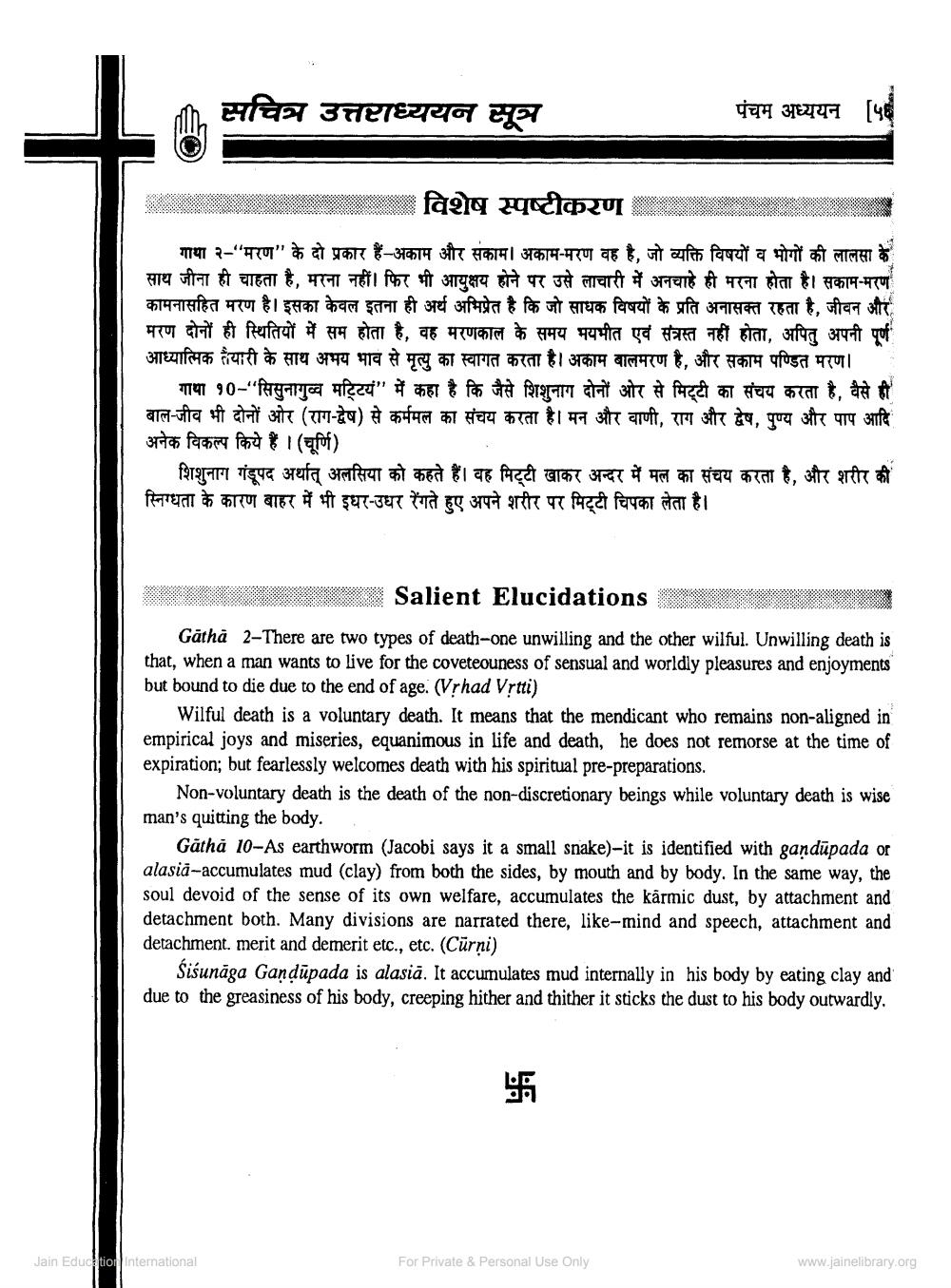________________
सचित्र उत्तराध्ययन सूत्र
पंचम अध्ययन
. विशेष स्पष्टीकरण
गाथा २-"मरण" के दो प्रकार हैं-अकाम और सकाम। अकाम-मरण वह है, जो व्यक्ति विषयों व भोगों की लालसा के साथ जीना ही चाहता है, मरना नहीं। फिर भी आयुक्षय होने पर उसे लाचारी में अनचाहे ही मरना होता है। सकाम-मरण कामनासहित मरण है। इसका केवल इतना ही अर्थ अभिप्रेत है कि जो साधक विषयों के प्रति अनासक्त रहता है, जीवन और मरण दोनों ही स्थितियों में सम होता है, वह मरणकाल के समय भयभीत एवं संत्रस्त नहीं होता, अपितु अपनी पूर्ण आध्यात्मिक तैयारी के साथ अभय भाव से मृत्यु का स्वागत करता है। अकाम बालमरण है, और सकाम पण्डित मरण। ___ गाया १0-"सिसुनागुव्व मट्टियं" में कहा है कि जैसे शिशुनाग दोनों ओर से मिट्टी का संचय करता है, वैसे ही बाल-जीव भी दोनों ओर (राग-द्वेष) से कर्ममल का संचय करता है। मन और वाणी. राग और द्वेष, पण्य और पाप आदि अनेक विकल्प किये हैं । (चूर्णि)
शिशुनाग गंडूपद अर्थात् अलसिया को कहते हैं। वह मिट्टी खाकर अन्दर में मल का संचय करता है, और शरीर की स्निग्धता के कारण बाहर में भी इधर-उधर रेंगते हुए अपने शरीर पर मिट्टी चिपका लेता है।
Salient Elucidations Gatha 2-There are two types of death-one unwilling and the other wilful. Unwilling death is that, when a man wants to live for the coveteouness of sensual and worldly pleasures and enjoyments but bound to die due to the end of age. (Vrhad Vrtti)
Wilful death is a voluntary death. It means that the mendicant who remains non-aligned in empirical joys and miseries, equanimous in life and death, he does not remorse at the time of expiration; but fearlessly welcomes death with his spiritual pre-preparations.
Non-voluntary death is the death of the non-discretionary beings while voluntary death is wise man's quitting the body.
Gāthă 10-As earthworm (Jacobi says it a small snake)-it is identified with gandūpada or alasia-accumulates mud (clay) from both the sides, by mouth and by body. In the same way, the soul devoid of the sense of its own welfare, accumulates the karmic dust, by attachment and detachment both. Many divisions are narrated there, like-mind and speech, attachment and detachment. merit and demerit etc., etc. (Cūrni)
Siśunaga Gandūpada is alasia. It accumulates mud internally in his body by eating clay and due to the greasiness of his body, creeping hither and thither it sticks the dust to his body outwardly.
Jain Education International
For Private & Personal Use Only
www.jainelibrary.org




